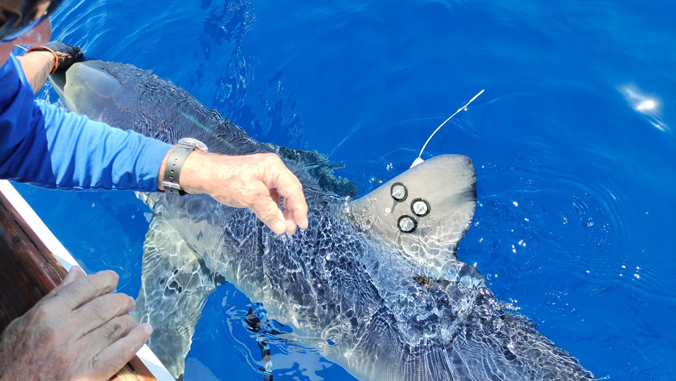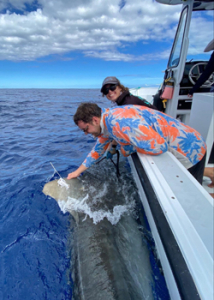
In a first-of-its-kind effort, a 3-meter long blue shark in the Atlantic Ocean is aiding researchers with a highly sophisticated sensor that provides oceanographic data in real time. The study is led by University of Hawaiʻi at Mānoa Hawaiʻi Institute of Marine Biology (HIMB) Research Professor Kim Holland together with colleagues at the University of the Azores. This was part of an expanding “Sharks as Oceanographers Program” funded by the Pacific Islands Ocean Observing System.
The bathygraph (a graph of the relationship between depth and temperature) tag enables the shark to record ocean temperature as it roves the water column and transmit the data via satellite when it resurfaces. Researchers can access the data in near real time, and the tags are designed to fall off after roughly four months.

“The bathygraph tags are an example of the increasingly sophisticated animal telemetry tools that are available to scientists,” said Holland. “These tags are now able to tell us not only where the animal is, but they can also describe the environment that it is experiencing. In the future this will include parameters such as oxygen content and plankton density.”
The most recent shark to be tagged in Hawaiʻi was a 4.2-meter long tiger shark in September 2024 near Kāneʻohe Bay. It is now 280 miles away at Nihoa Island and provides a steady stream of temperature and depth profiles.
Sharks gather interesting findings
The data from both sharks is already yielding some surprising results.
“An unexpected result from the tracking experiments is how deep these supposedly coastal, or surface-oriented species, dive,” said Holland. “Both the tiger and blue sharks regularly dive to over 500 meters, where the water is much colder than at the surface.”
Tracking experiments offer a sense of “instant gratification” because the animal’s movements and the associated oceanographic data can be viewed in near-real time.
“The blue shark is now 300 miles south of where we tagged it [in the Azores], and it has already produced over 70 temperature/depth profiles,” said Holland. “So we have two sharks simultaneously in two oceans, providing critical habitat information and high quality oceanographic data.”
The HIMB Shark Research Lab will continue its efforts to provide year-round data on ocean structure in Hawaiʻi, and it plans to expand its work to include different species—including blue sharks in Hawaiʻi.
–By Maria Frostic

